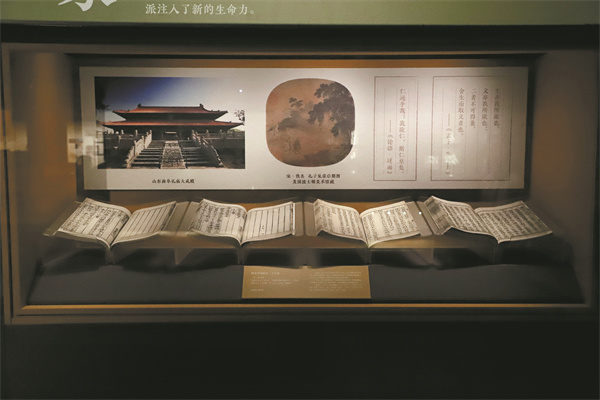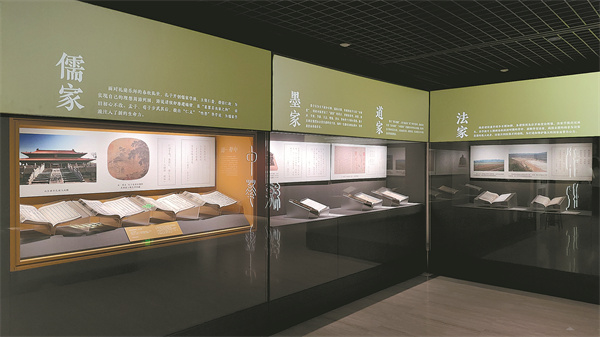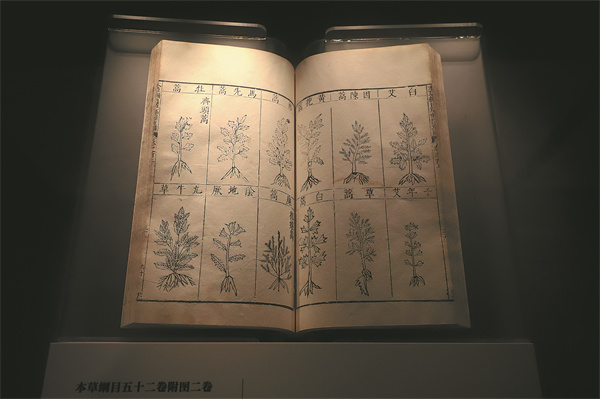
An ancient edition of The Four Books, with annotations by scholars, is displayed in an exhibition hall of the National Museum of Classic Books, from which puzzle-solving game players can uncover clues.[Photo provided to China Daily]
In an exhibition hall of the National Museum of Classic Books, located within Beijing's National Library of China, real-time puzzle game players use guidebooks while checking passages in ancient classic books, and searching for clues to solve the game.
Feng Wanwen, a player of the immersive, interactive puzzle-solving game Ancient Book Restorer — Hundred Cities Book, scanned a QR code on the guidebook to receive missions to find the hidden "truth" on the game's WeChat mini-program. The game is won by completing puzzles with clues hidden in exhibits, such as oracle bones, bamboo and wooden slips, stone inscriptions and rare ancient books.

Players must comprehend the texts and pictures to solve the puzzles, including from the books Compendium of Materia Medica, Shan Hai Jing for players.[Photo provided to China Daily]
The museum launched the exhibition in September 2024 as part of celebrations for the 10th anniversary of the establishment of the National Museum of Classic Books founded by the national library.
Entry to both the exhibition and interactive gaming is free.

Players must comprehend the texts and pictures to solve the puzzles, including from the books Classic of Mountains and Seas, and guidebooks for players.[Photo provided to China Daily]
Hiding the first clues, a version of Shan Hai Jing (Classic of Mountains and Seas) published in 1180 during the Song Dynasty (960-1279) is the book's earliest edition found to date. Players need to have a specific understanding of the distance between mountains, and then find the answer to the first puzzle using a specially designed "ruler". The "ruler" is made of paper with the mountains' information printed on it. Players will find the answer once it's folded.

Players participate in the puzzle-solving game in the National Museum of Classic Books' exhibition hall located in Beijing's National Library of China.[Photo provided to China Daily]
Feng says she enjoyed the process of using the "ruler".
"Players must understand the text of Shan Hai Jing and fold the ruler the right way to get the answer," she says.
Among the 83 exhibits, more than 20 provide clues to the game. As the game's storyline goes on, the players need to read, understand, and analyze the text of ancient books and use ancient maps.

Players participate in the puzzle-solving game in the National Museum of Classic Books' exhibition hall located in Beijing's National Library of China.[Photo provided to China Daily]
Dai Ying, the founder of Puzzle Master, a puzzle game design team, says the principle of the game is to encourage players to read the text of the ancient books on display and use that knowledge to complete the puzzle.
"The game produces a real connection between the players and the exhibits. They become 'cocreators' of the exhibition's innovation, helping transition the educational functions of the museum," says Dai.

Players participate in the puzzle-solving game in the National Museum of Classic Books' exhibition hall located in Beijing's National Library of China.[Photo provided to China Daily]
Players can reserve the game on the museum's WeChat account and choose the single-role or three-role versions. They will act as ancient classic book protectors trying to find answers to puzzles with a good understanding of the hidden clues and achieve their goal of protecting the ancient books.
In the single-role version, the mission is to investigate a mysterious situation in the exhibition hall at midnight — the ancient book Shan Hai Jing turns its own pages.
If players choose the three-role version, a three-person group is necessary. Each player follows different parts of the storyline and completes different puzzles. Cooperation and competition will happen. Because a saboteur is hidden in the group, betrayals and cheating will shock the players. If the saboteur wins the game in the three-role version, players will have to face the "consequences" of failing to protect the ancient books.

Players must comprehend the texts and pictures to solve the puzzles, including from the books Ben Cao Gang Mu for players.[Photo provided to China Daily]
After the single-role version was launched in November 2024 and the three-role version on Jan 23, the game has quickly become popular among puzzle enthusiasts and traditional culture fans. By late January, about 1,000 players participated in the game. Chen Weiwei, from the exhibition department of the National Library of China, reveals that the reservation quotas regularly sold out in one minute.
Feng tried many times to make a reservation and finally played the game with a friend three weeks after its launch. The two young women walked around the exhibition hall, talked about the storyline in low voices, and browsed the pages of the ancient books that provided clues. They spent more than an hour completing the game. The answer to the final puzzle revealed a deeply touching motto that encourages the inheriting of ancient classics.
The game is a subprogram of the originally designed IP Shanhaishe, a virtual community for the protection and restoration of ancient books, which was named after the classic Shan Hai Jing and initiated by the museum in 2019.
"We developed the Shanhaishe IP and created a series of puzzle-based activities, hoping to introduce similar activities alongside major exhibitions in the future," says Gu Heng, director of the exhibition department at the National Library of China.